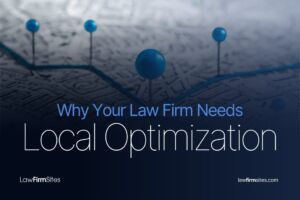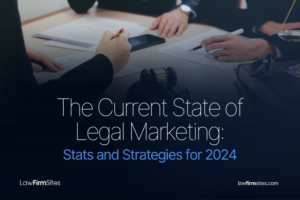The Ultimate Bounce Rate Guide

When it comes to Internet marketing and web traffic analysis, some of the most frequently asked questions involve bounce rate. What is Bounce Rate in Google Analytics, and what does bounce rate mean? Does it really make a difference in the long run?
Spoiler alert: Bounce rate is very impactful to your site, which can then greatly impact your law firm.
So here’s everything you need to know—
- What Does Bounce Rate Mean?
- How Is Bounce Rate Different From Exit Rate?
- What Is a Good Rate?
- How to Lower Your Page’s Bounce Rate
- How We Can Help
What Does Bounce Rate Mean?

Bounce rate is the percentage of visitors that visit a single page on your website and then leave without taking any other action.
An action can be anything from clicking a link, to filling out a form, to making a purchase. Essentially, you want your reader to visit your site and then do something (anything!) before leaving. Ideally, you want your reader to engage with your services.
Law websites, especially, need readers to take the next step before closing out the webpage or they may not return.
So here are two reasons why bounce rate matters—
Lower bounce rates mean higher conversions.
Each person who visits your law firm website will either bounce (take no action) or convert (complete an action on your site). A low law firm website’s bounce rate and a high conversion rate signal a successful site.
And a successful site ultimately means more impact, more contacts, and more revenue.
Lower bounce rates indicate audience satisfaction.
When readers complete actions on your site—clicking links, going to different pages, completing forms—it lowers your bounce rate and indicates to Google and other search engines that readers are finding what they’re looking for or discovering relevant information on your page.
This is incredibly important since search engines want to promote sites that make readers happy.
Readers visiting attorney websites, for example, are typically looking for helpful information about what next steps they should take to answer their legal questions or solve their legal problems.
If readers leave your website quickly, it indicates they aren’t finding the information they need. And very often, this means those readers will not return to your site.
Lowering your website’s bounce rate has all kinds of benefits in search engines and in ultimately attracting a wider audience and new clients.
Essentially, bounce rates are important because they tell you how well people are (or aren’t!) engaging with your site. The good news?—bounce rates can be improved.
How Is Bounce Rate Different From Exit Rate?

The terms bounce rate and exit rate are easily and often confused. So let’s quickly break them down.
We know bounce rate means a reader visited a single page and then left without taking any action. So what is exit rate?
Exit rate indicates the percentage of exits made from a particular page.
In other words, exit rate answers this question: How often was a particular page on your website the last page the reader viewed before leaving your site?
Ideally, the exit rate for most of your website’s pages will be similar. If one page stands out as having an unusually high exit rate, you know you need to dig into the reason.
(Hint: This is where attorney SEO marketing experts can be very helpful! Sometimes an outside source can quickly identify why your site is struggling and what you can do to make it successful.)
Here’s a helpful video for understanding the difference between bounce rate and exit rate:
Exit rates are helpful information because they help you determine where your website might need additional work. If your About page has an extremely high exit rate, for example, you know you need to add links, forms, or other opportunities to keep your reader engaged with your site.
While a high bounce rate may indicate that the reader isn’t engaging with your website, a high exit rate may indicate that the reader isn’t engaging with a specific page on your site.
Again, good news: When it comes to lawyer websites, both the bounce rate and exit rate can be improved. It may even be easier than you think.
What Is a Good Rate?
The short answer: Generally speaking, a 41–55% bounce rate is considered average, and a 26–40% bounce rate is considered optimal.
That said, it’s important to keep in mind the structure of your website as well as the purpose of each page.
Retail pages, for example, have different average bounce rates (24–40%) than blogs (70–98%).
And the average bounce rate for legal websites is about 60%—which is higher than the general standard—but this percentage creates an amazing opportunity for legal websites that do the work of lowering their bounce rate.
Lawyer SEO—or improving the quantity and quality of your website’s traffic—can make an incredible impact on your business. Too many law offices underestimate the power of strong legal website SEO.
Many law firms pour money into television or print ads while essentially ignoring their online presence.
But in this digital age, they have it backward.
In fact, your website can be one of the strongest tools in your advertising belt.
How to Lower Your Page’s Bounce Rate

Here are 10 quick tips and tricks to lower your bounce rate.
1. Re-order your page.

Put your most important information near the top. Readers don’t want to scroll and scroll and scroll to find the answer to their legal question. Validate for your readers that you are going to deliver whatever you’ve promised in the title. And do it before they give up.
2. Meet expectations.
Along the same lines, it’s important to learn what your reader expects from each of your web pages and then work to meet those expectations. Is your reader looking for short articles or in-depth reviews? Does your reader need minimal text or lots of graphics? (A high bounce rate indicates that current expectations are going unmet.)
3. Optimize your page speed.

Slow page speeds are a bounce rate’s best friend. A recent study shows that the average reader will only wait 2 seconds for a page to load before leaving. Along these lines, unnecessary plug-ins can slow your page’s speed. Make sure you only activate the plug-ins you actually need. There is always something you can do to accelerate your load time.
(Not sure what your options are for optimization? We can help!)
4. Pay attention to pop-ups.

Used carefully, pop-ups can be effective. But very often, pop-ups just push readers away. If your readers aren’t determined to stay on your site before the pop-up occurs, they likely will not stay afterward. Be careful not to bombard your readers with unnecessary ads, subscribe buttons, or premature surveys as well.
5. Create great content.
No matter how fast or beautiful your website is, if your content is weak, your readers will not stay. This is one of the simplest but most powerful secrets when it comes to SEO for lawyers: The #1 way to keep people from bouncing off your site is to give them the information they need.
6. Make your website mobile-friendly.

Mobile responsiveness is the term that indicates whether a website is both aesthetically pleasing and fully functional on different devices. Considering how many people browse the Internet from phones and tablets—as opposed to bigger computer screens—it’s critically important that websites work on all devices. Not sure how mobile-friendly your site is? Do some research. Look at it from every possible device. Ask your friends to weigh in with their opinions.
If your site isn’t great on a phone, you’ll probably maintain a high bounce rate.
7. Revise meta information.

When it comes to SEO for attorneys, this one is big. Title tags and meta descriptions are incredibly important for low bounce rate. If your title tags and meta information don’t accurately summarize your webpage, readers will come and go quickly.
8. Improve your navigation.
One reason readers are quick to leave is because a website makes it difficult to move around efficiently. Generally speaking, readers don’t want to have to dig for their information. Does your website offer a search box? Are the menu items clear and easy to navigate—even on a smartphone? Make it as easy as possible for your readers to want to stay on your site.
9. Improve your design.

How a page looks matters as much as what a page says. And while content is king, the design must be good or people won’t stay around to read the content. Use lots of white space on each page. Add clear, high-resolution, images wherever appropriate. Keep your sentences short. Use good grammar and spelling. Use ads sparingly.
10. Review your analytics.
Google Analytics is a site owner’s best friend. Google Analytics tracks important website activity—including, but not limited to—session duration, bounce rate, traffic source, and pages per session. This information empowers you to make the right changes that will make your website even stronger.
How We Can Help
Understanding bounce rates is incredibly important to building a successful website. But if you don’t want to go through the process of improving your bounce rate (or if you don’t have the time or desire to do it yourself), we can help.
As a successful agency that provides law firm SEO services, we can help optimize your site and put you in the best position to expand your business.
Check out some of the amazing clients we’ve been privileged to work with through the years.
Here at Law Firm Sites, we are proud to say we’ve built or improved websites for thousands of clients. With over 20 years of experience, we’ve learned the tips and tricks that can make your website what you need to attract the clients you want.
Let’s work together and get started. Contact us today.
Enjoy this post? Here are some others you’ll like.
Did you like this post? Here are some others you might enjoy:

Search Engine Optimization (SEO) has become a critical tool for law firms to stand out. It drives more visitors to…

It’s easy to forget that every business is a ‘local’ business to someone. This is especially true for legal firms and attorneys who often…

The legal industry is constantly evolving, and law firms need to stay up to date with the latest digital marketing…




